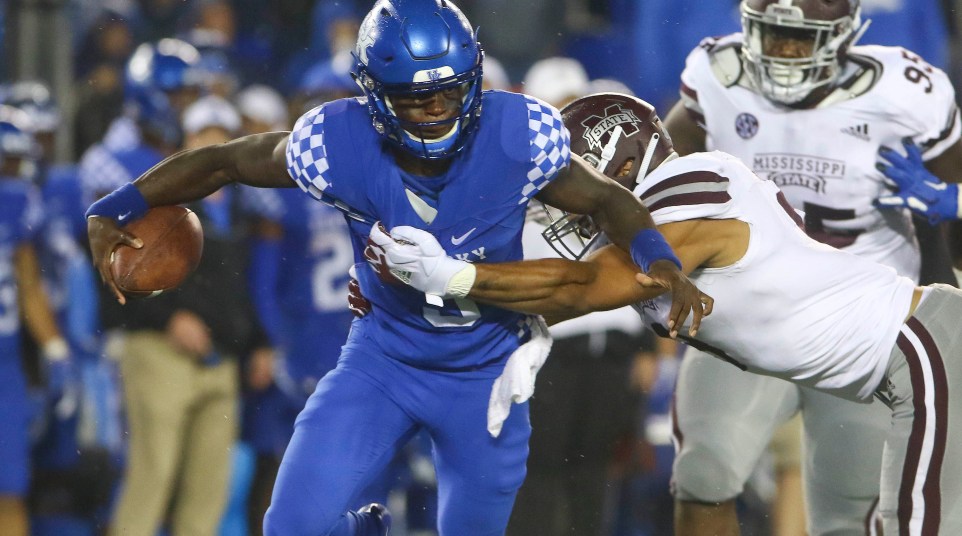
Who's under center in Lexington? The story beneath the stats on Kentucky's Terry Wilson
Here in Bizarro World, Kentucky is a co-leading the SEC East and ranked 12th in the nation. And the Big Blue Nation fan base is in a tizzy about the quarterbacking. On the heels of Mark Stoops’ comments that he expects to play multiple quarterbacks on Saturday against Missouri, it’s as good of a time as any to review Kentucky’s passing game and the hidden and not-so-hidden costs and benefits of UK’s options.
Before the season, many (present company included) expected Stoops to give at least the first shot to sophomore QB Gunnar Hoak, a traditional drop-back passer whose main strength is passing accuracy. The decision to go instead with Terry Wilson was not shocking — Wilson is much fleeter of foot and has arm strength. That said, Wilson has struggled greatly with reading defenses and with decisiveness, particularly in the Texas A&M loss, when he had massive struggles in discerning when to remain in the pocket looking to throw and when to take off and run.
The common logic heard throughout BBN is that backup QBs Hoak and Danny Clark would struggle not to replicate Wilson’s results — but that’s frankly an oversimplification.
Wilson’s productivity will be harder to equal than first appearance suggests.
For the season, Wilson has throws 122 passes in seven games — about 17 passes per game. He has gained 721 yards passing, which translates to 103 yards in the air per game. Admittedly, that statistic would be difficult for Hoak and/or Clark not to equal.
But Wilson has carried the ball 78 times for 395 yards. Those stats include that he has been sacked 10 times for -61 yards. Ten sacks allowed in 7 games is probably a testimony to UK’s strong offensive line, the lack of pass plays called, and Wilson’s elusiveness.
It’s a very low number for UK. In 2017, even with mobile QB Stephen Johnson keying a run-first offense, UK gave up 31 sacks. The lack of sacks is not insignificant, nor are Wilson’s 68 rushes for 456 yards. In essence, then, Wilson gains about 65 yards per game on around 10 carries, and is sacked only about 1.5 times per outing.
The hidden facet here is that Wilson’s rushing ability (those 395 yards are 16th in the SEC and second among SEC QBs) opens up the middle of defenses for Snell.
Many of the most critical observers proclaiming that a team must have a successful passing game to prevent defenses from sitting on the run are overstating their mark. Offenses must be diverse enough to prevent defenses from sitting on the same running play or plays.
Earlier this season, Georgia Tech put up 66 points on Louisville in a game in which they were 1-for-2 passing for 10 yards. Tech didn’t have to pass to put up yards and points, they just had to run the ball from enough different looks and angles that Louisville never knew which threat to respect—the back up the middle, the quarterback on a keeper, a receiver on an end around … that’s largely how Kentucky has ground out yardage this season.
Don’t believe it? The tape doesn’t lie. Look at this pivotal 3rd-and-4 on UK’s own 26 in the fourth quarter against Vanderbilt.
Everybody in Kroger Field was relatively certain this was a running play. But Wilson’s presence on the RPO kept defenders on the edges occupied long enough to avoid clogging the lane that Snell exploits for 20 yards on what became the game-winning drive.
Kentucky will apparently now parcel up the quarterbacking situation. But this is the rub — if Hoak and/or Clark plays a full game, sure, they’ll easily surpass 103 passing yards. Although the margin by which they surpass it is open for discussion on a Kentucky team that has Lynn Bowden and a group of thoroughly undistinguished receivers. Maybe Hoak or Clark passes for 150 yards, or even 180.
Hoak and/or Clark won’t add 65 rushing yards. Neither is exactly lead-legged, so they’ll probably have a decent gain or two — which will likely be offset by giving up an additional sack or two.
And on a pivotal 3rd-and-4, will the defense respect either passer either as a pure drop-back passer or as an RPO threat sufficient to keep the secondary from clogging the middle of the field?
That’ll be the ultimate question.
Because if not, Hoak and/or Clark will have to throw for a lot of yards to offset the hidden yards Wilson creates with his legs — and, more important, the fact that his presence creates space for Snell. And every pass attempt will take the ball out of the hands of Snell, who happens to lead the SEC in rushing and regardless of who is under center, remains the best offensive player on this Kentucky team.
On the other hand, maybe Wilson does pick it up a bit via the air. If he could pass for even 140 yards per game, given all the additional rushing yards and hidden RPO yards, he would likely quickly retain his role as the sole QB in Lexington.
In any case, the QB derby adds another layer of interest to Saturday’s showdown at Missouri. As the axiom goes, there’s more than one way to skin a cat, but the Wildcats will need to figure out quickly which offensive attack can skin a Missouri Tiger.
